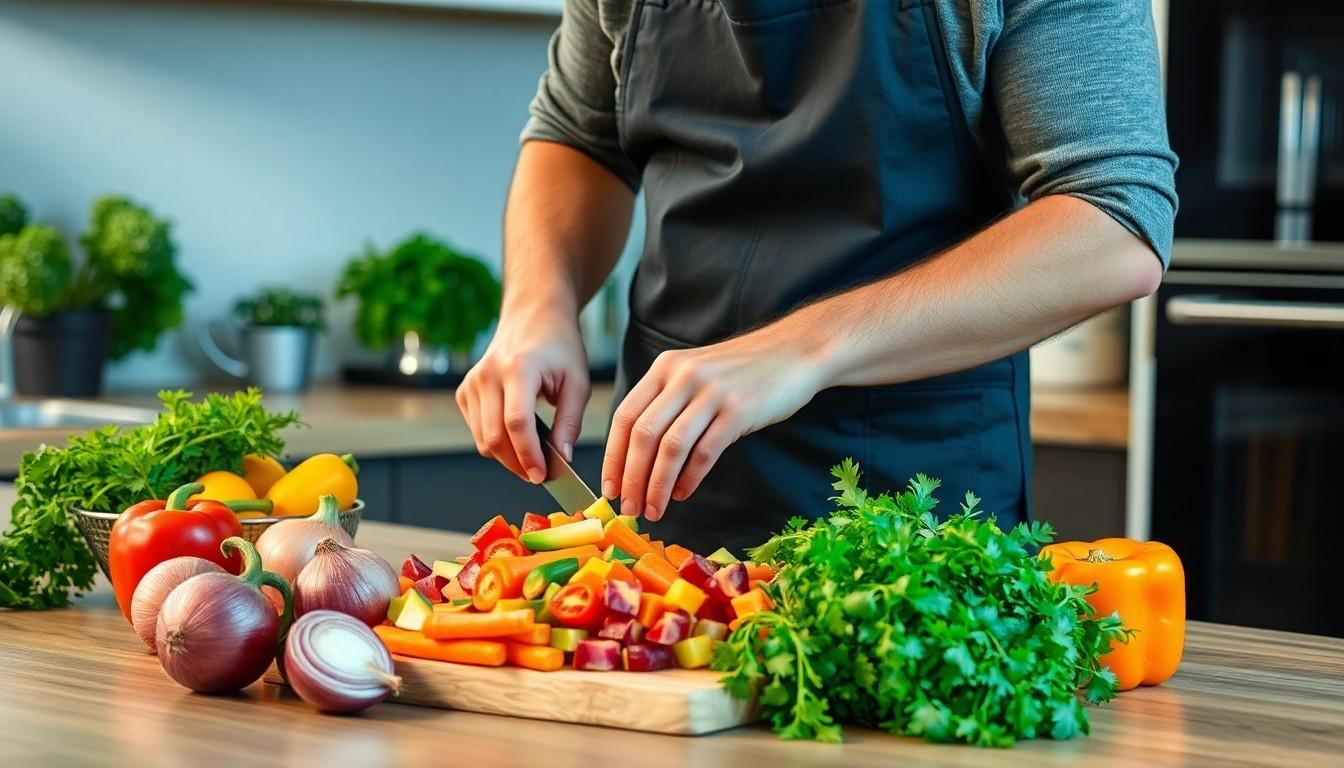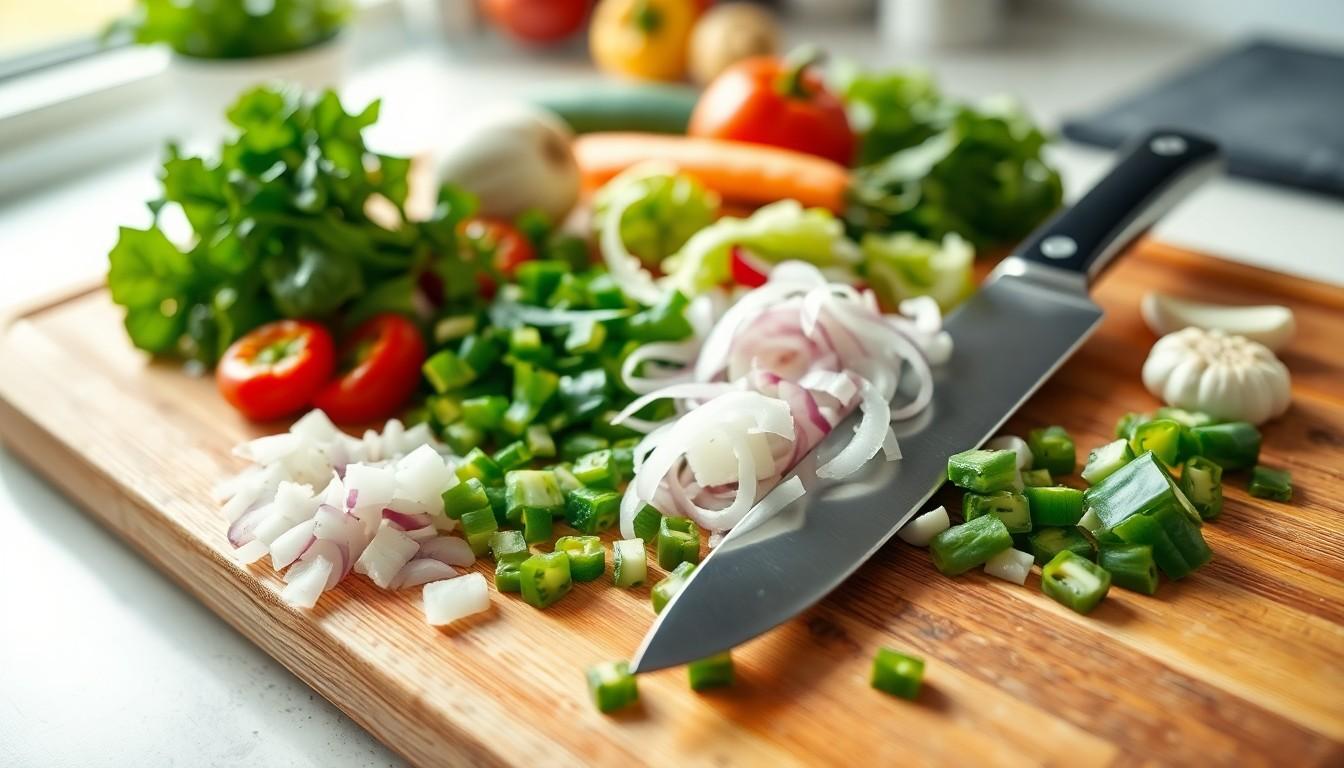Phone:
(701)814-6992
Physical address:
6296 Donnelly Plaza
Ratkeville, Bahamas.

When it comes to cooking, mastering cutting techniques can be the secret ingredient to elevating any dish from mediocre to mouthwatering. Whether you’re dicing onions that make you cry or julienning carrots like a pro, the right technique can save time and make your meal prep feel like a culinary dance party.
Mastering various cutting techniques enhances culinary performance and improves dish presentation. Techniques like dicing, slicing, and chopping play crucial roles in meal preparation.
Dicing transforms vegetables into uniform cubes, ideal for soups and salads. For instance, diced tomatoes add consistency to a fresh salsa.
Slicing, on the other hand, allows for even cooking and is perfect for meat. Thinly sliced chicken encourages quicker cooking times, resulting in a more tender texture.
Chopping encompasses a versatile method suitable for different ingredients. Whether chopping garlic or herbs, this technique infuses flavors throughout dishes.
Julienne techniques involve cutting food into thin strips. This method, often used for carrots or bell peppers, enhances visual appeal and promotes even cooking.
Mincing refers to finely chopping food into smaller pieces, commonly used for garlic and onion. This technique maximizes flavor release, providing depth to various recipes.
Brunoise serves as a precise dicing method, creating small and uniform cubes. Often used for vegetables like bell peppers, brunoise adds sophistication to presentations.
Recognizing the appropriate cutting technique for each ingredient elevates cooking effectiveness. Applying these methods consistently improves meal preparation efficiency, leading to better overall results.
Familiarity with these cutting techniques fosters confidence in the kitchen. Chefs and home cooks alike can appreciate the heightened experience that comes with expertly prepared ingredients.

Mastering cutting techniques enhances meal preparation and overall cooking efficiency. Various methods cater to specific needs, improving presentation and flavor.
Chopping involves cutting ingredients into irregular pieces. This technique suits vegetables like onions, peppers, and garlic. Quickly chop for stir-fries and soups. Use a rocking motion with the knife for speed. Uniformity isn’t crucial, but consistency in size aids even cooking.
Slicing delivers clean, thin cuts of food. This method is ideal for meats, cheeses, and fruits. Aim for even thickness to ensure uniform cooking and easy serving. Utilize a smooth motion with a sharp knife to achieve finesse. Use this technique for sandwiches, salads, and garnishes.
Dicing produces uniformly sized cubes. Small, medium, and large dice repair for different culinary applications. Use this method for vegetables in salads and soups. Start with slices, then cut crosswise. Precision in size improves cooking times and dish presentation.
Mincing creates very small, finely chopped pieces. This technique works well for garlic, herbs, and ginger. Mincing releases more flavor, enhancing dishes like marinades and dressings. Use a sharp knife and a rocking motion for efficiency. Proper mincing elevates the overall flavor profile of recipes.
Specialized cutting techniques enhance culinary skills and improve dish presentation. Mastering methods like julienne, brunoise, and paysanne elevates cooking from basic to impressive.
Julienne involves cutting ingredients into long, thin strips. This technique works well with vegetables like carrots and bell peppers, providing a beautiful presentation for salads and stir-fries. To julienne, start by slicing the vegetable lengthwise, creating thinner sheets. Next, stack these sheets and cut them into strips, achieving uniformity in size. The precision of julienne helps dictate cooking times, ensuring even softness when sautéed.
Brunoise creates tiny, uniform cubes from vegetables like onions and celery. Achieving this requires dicing the vegetable into julienne strips first. After that, cutting the strips into small, precise cubes forms the brunoise shape. This technique serves well in sauces, soups, and garnishes, where the size adds to the visual appeal and enhances cooking efficiency. A consistent brunoise contributes to blending flavors more effectively in dishes.
Paysanne cuts ingredients into thin, flat pieces, often triangular or round. This technique adds variety to textures in salads or garnishes. To achieve paysanne, slice the vegetable into uniformly thin rounds, and then cut those rounds into desired shapes. This method works well for root vegetables and can provide a beautiful contrast on the plate. Paysanne is particularly effective in adding visual interest and balance to dishes.
Handling knives safely is paramount in any kitchen. Start by using a sharp knife; dull knives can slip and lead to injuries. Ensure proper grip; hold the handle firmly and tuck fingers on the opposite hand.
Keep cutting surfaces stable. Use a cutting board that won’t slide around; placing a damp cloth underneath can provide extra stability. Always cut away from the body; this minimizes the risk of accidental cuts.
Wear protective gear, such as cut-resistant gloves, especially when performing intricate techniques. Keeping knives separate from other utensils prevents accidental cuts during storage.
Maintain focus while cutting; distractions can lead to slips and accidents. Avoid multitasking in the kitchen when handling sharp tools.
Store knives properly. Use knife blocks or magnetic strips that protect blades and edges. Regularly inspect cutting tools for damage or wear; replace any that show signs of deterioration.
Train beginners in proper techniques before they start cutting. Teaching them about the importance of safety and control ensures a safer cooking experience.
Always clean up spills promptly to prevent slipping or falling in the kitchen. Following these simple safety tips fosters a secure environment, allowing focus on mastering cutting techniques.
Mastering cutting techniques is vital for anyone looking to enhance their cooking skills. These methods not only improve the efficiency of meal preparation but also elevate the overall quality of dishes. As individuals become more familiar with various techniques they’ll find that cooking becomes a more enjoyable and creative process.
By prioritizing safety alongside skill development cooks can confidently navigate the kitchen. Embracing these cutting techniques paves the way for more flavorful meals and impressive presentations. With practice and attention to detail anyone can transform their culinary experience.